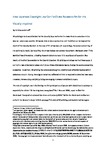How Japanese copyright law can facilitate access to art for persons with a visual impairment

Date
2020-01-07Author
Subject
Metadata
Show full item recordAbstract
This chapter examines the extent to which Japanese copyright law supports or hinders sensory art, mainly in reference to the three-dimensional (3D) printing of art works for persons with a visual impairment (PVI) by cultural heritage institutions. It focuses on cultural heritage institutions in particular, as these are, in the first instance at least, the most likely institutions carrying out this kind of project as pilots. The chapter examines 3D printing as a process from the copyright angle to identify when and how copyright law is relevant. Japanese copyright law defines copyright works as the creative expression reflecting the author’s emotions, especially in the fields of literature, science and scholarship, art and music. In conclusion, making 3D copies of copyright protected art works is permitted under Japanese copyright law as long as it is for the benefit of and limited to PVI.
Collections
Publisher
Editor
Parent title
Number
Recommended, similar items
The following license files are associated with this item:


